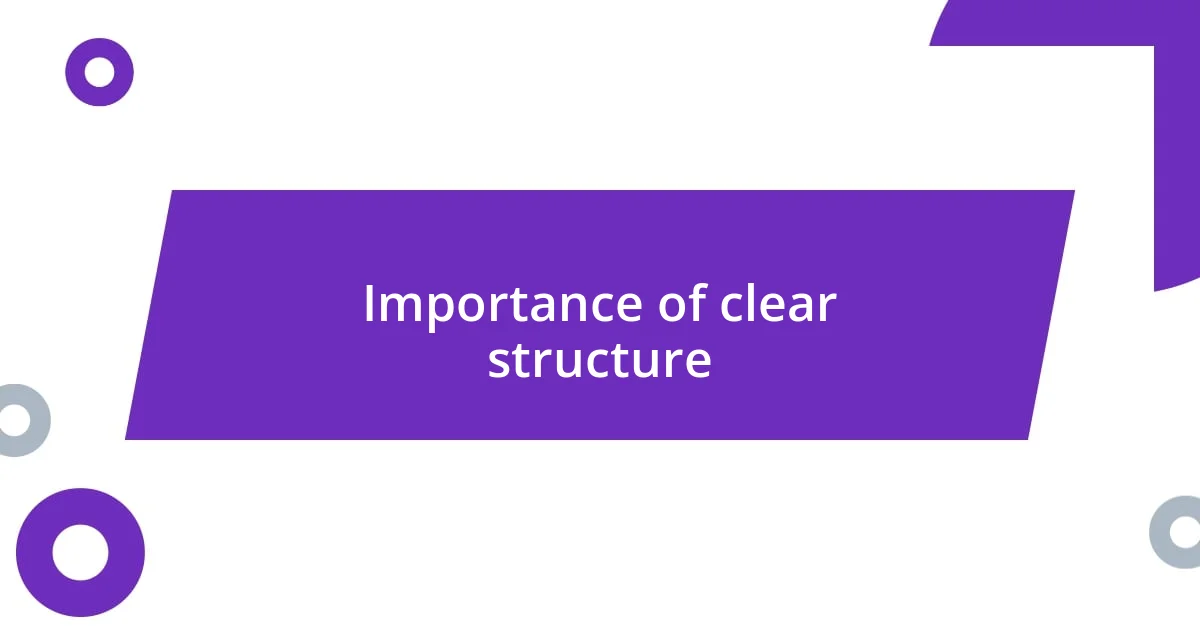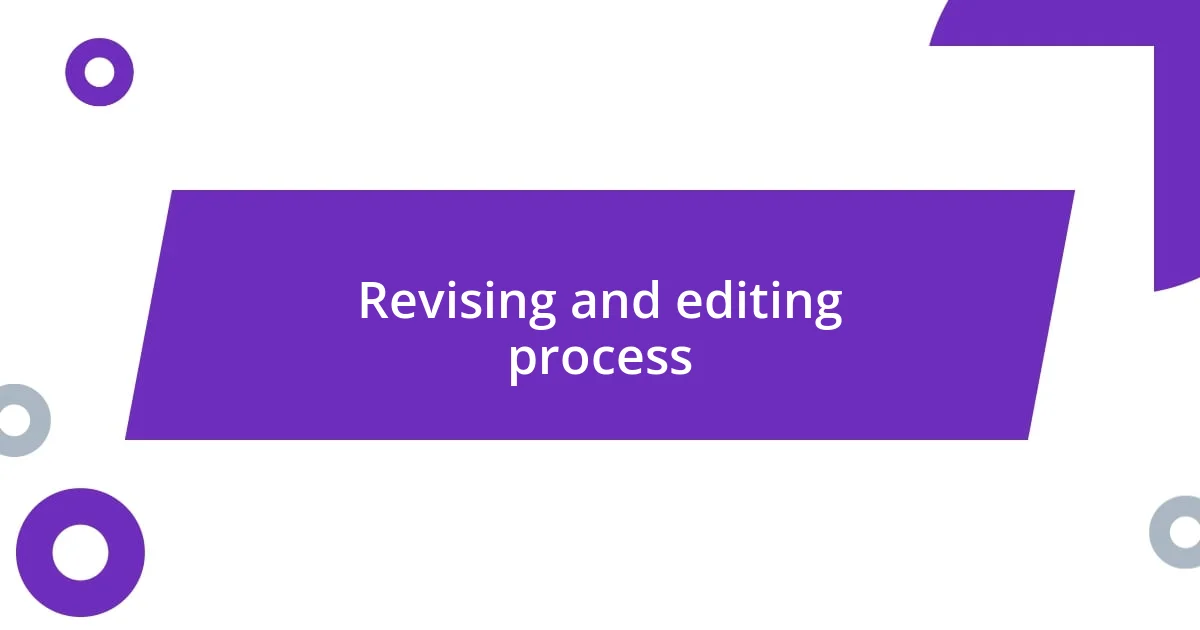Key takeaways:
- Understanding and applying writing guidelines enhances clarity, coherence, and reader engagement.
- Establishing a clear structure and targeting the audience leads to more focused and relevant content.
- Revising and gathering feedback are crucial for refining writing and improving overall quality and impact.

Understanding writing guidelines
Understanding writing guidelines can feel a bit daunting at first, but I’ve learned that they serve as a roadmap to strengthen my writing. When I first started writing seriously, I often felt overwhelmed by conflicting advice. It was through perseverance and trial and error that I realized these guidelines aren’t just rules; they’re tools to enhance clarity and coherence.
I remember when a mentor advised me to keep my audience in mind while writing. It struck me how much easier it becomes to follow guidelines once I understood that they protect the reader’s experience. For instance, adopting a conversational tone and using shorter sentences—something I previously resisted—made my pieces more engaging and accessible.
Why do we sometimes overlook the value of these guidelines? I’ve noticed that when I forget them, my writing can drift into complex territory, losing the reader’s attention. Reflecting on this, I see that embracing these principles not only fosters better communication but also allows my unique voice to shine through while keeping the reader engaged.

Importance of clear structure
A clear structure in writing acts like the bones of a body—it gives form and support to the entire piece. I can’t emphasize enough how organizing my thoughts before I even start drafting has transformed my writing process. When I failed to create an outline, I often found myself wandering aimlessly, leaving readers confused and lost. It was a wake-up call when a reader once told me they couldn’t follow a piece because it lacked logical flow. That feedback has stayed with me, prompting me to prioritize structure.
- A well-defined structure guides readers from point to point, making content easier to follow.
- It helps me remain focused on my central argument, preventing me from veering off track.
- A clear layout invites readers to engage more deeply, enhancing their overall experience.
- Using headings and bullet points breaks up dense information, making it digestible.
- I’ve found that revisiting and refining my structure often leads to deeper insights and better clarity in my writing.

Effective audience targeting
Understanding my audience has been a game changer in my writing journey. Initially, I would choose topics that intrigued me, often disregarding whether my audience would find value in them. In one particular instance, I wrote a piece filled with technical jargon that I found fascinating, but it fell flat with readers. That experience taught me the importance of considering who will be reading my work and adjusting my approach to meet their interests and needs.
When I think back on that pivotal moment, I realize the key is empathy. It’s about stepping into the readers’ shoes, understanding their questions, and addressing them. I often ask myself, “What do they want to learn? How can I provide that clarity?” By consistently refining my focus on the audience, I’ve seen a marked improvement in engagement and feedback. It’s not just about writing; it’s about connecting.
One effective method I’ve adopted is developing reader personas. Crafting profiles for my ideal readers helps me visualize who I’m writing for. These personas include demographics, interests, and pain points. This practice has consistently driven my content decisions, ensuring that what I write resonates deeply with those I aim to reach. I encourage anyone serious about writing to give this approach a try; the clarity it brings is invaluable.
| Strategy | Description |
|---|---|
| Develop Reader Personas | Create profiles for your ideal audience to tailor content to their needs. |
| Audience Feedback | Engage with readers to understand their preferences and adapt your writing accordingly. |
| Content Relevance | Choose topics that align with audience interests for improved engagement. |
| Empathy in Writing | Put yourself in the readers’ shoes to craft relatable and engaging content. |

Crafting precise language
Crafting precise language is a skill I’ve honed over time, and it often shows in the clarity of my writing. I remember a time when I used overly complex phrases in an attempt to sound more sophisticated, only to receive confusion from my readers. It was a humbling experience, realizing that simplicity often conveys my message more powerfully. I’ve since made it a point to use exact words that reflect my thoughts clearly.
For instance, when I describe a product, I focus on specific features rather than vague adjectives. Instead of saying “nice” or “good,” I might say “durable” or “high-quality.” This shift in precision not only gives readers a clear picture, but it also builds my credibility as a writer. Have you ever noticed how certain words can evoke vivid images in your mind? This is why I strive to choose my vocabulary carefully—it’s about painting a clear picture for my audience.
Additionally, I find that simple phrases often resonate more with readers. When I say “save time with our feature,” it’s much clearer than “achieve efficiency through advanced technology.” The former directly addresses a reader’s need, while the latter feels abstract and distant. Emphasizing precise language has significantly improved how effectively I communicate, allowing me to connect more deeply with my audience while ensuring that my message is unmistakably understood.

Using visual aids effectively
Using visual aids effectively can truly elevate your writing, making it more engaging and easier to digest. I’ve learned this firsthand during a presentation where I incorporated infographics and images to illustrate points. The audience’s eyes lit up when they saw a visually appealing chart, and suddenly, the complex data I was discussing transformed into something relatable and impactful. Have you ever noticed how visuals can often convey a message faster than words alone? It’s fascinating how a well-placed image resonates with emotions, making information memorable.
I also remember a blog post on a complicated topic that I once tackled without any visuals. It was a struggle to keep my readers engaged, and I received feedback that many felt overwhelmed. So, I went back, added diagrams, and broke down the content into bite-sized pieces. The response was immediate—people found clarity and connection. Isn’t it interesting how a simple visual can make dense information more approachable? In my experience, visuals not only clarify concepts but also stimulate interest and keep readers scrolling.
Furthermore, I’ve found that choosing the right type of visual can enhance the overall message. For example, a graph might effectively present statistical information, while a photograph can evoke emotion and storytelling. During one project, I used a series of before-and-after photos to showcase the impact of a community initiative. The emotional weight of those visuals drove home my point much more powerfully than words could. What kind of visuals could you explore to deepen your readers’ understanding? From my experience, thoughtful integration of visuals into writing can create a richer, more compelling experience for everyone involved.

Revising and editing process
Revising and editing are where the magic truly happens in writing. I often approach this phase with a fresh mindset, almost like it’s a new layer of creativity. I recall one particularly lengthy article I wrote, which I thought was polished until I realized I had left in unnecessary jargon that made it convoluted. After stepping away for a day, I came back to it with a clearer perspective, and the process of trimming down those sections felt liberating. Have you ever had that ‘aha’ moment in your revisions? It’s a reminder that our first drafts are just stepping stones.
While revising, I also pay attention to the flow of ideas. During one project, I recognized that my arguments danced around the main point instead of marching confidently towards it. I took the time to reorder my paragraphs, and suddenly, the piece felt more cohesive and compelling. By cutting out redundant sentences and ensuring each paragraph served a purpose, I could create a rhythm that guided my readers effortlessly through my thoughts. It’s fascinating how rearranging a few lines can transform a piece from chaos to harmony, don’t you think?
Editing, for me, is where I fine-tune my work down to its essence. I recall painstakingly combing through an essay, eliminating filler words that clouded my actual message. Each deletion, while sometimes hard, made the writing feel sharper and more impactful. I often ask myself: does this word choice add value? If not, it’s gone. Engaging in this meticulous process not only elevates my writing but also deepens my connection with readers, as I strive for clarity and precision in every sentence. What methods do you find helpful in your own revising and editing process? From my experience, embracing this phase not only improves the piece itself but also fosters a deeper understanding of my own voice as a writer.

Gathering feedback for improvement
Gathering feedback is an essential step in honing my writing. I vividly remember sharing a draft of a short story with a trusted friend. The insights they provided about character development and pacing opened my eyes to aspects I hadn’t fully considered. It made me realize how valuable an outside perspective can be. Have you ever wondered how much a fresh set of eyes can transform a piece?
I find that creating a safe space for feedback encourages honesty and open conversation. After presenting an article during a writer’s workshop, I asked for constructive criticism. The responses ranged from compliments to suggestions for deepening my argument. I was surprised by how much I learned from the group, and it motivated me to revisit my work with newfound energy. How often do we think we’ve nailed it until someone points out the blind spots?
Incorporating diverse feedback is equally important. I once combined insights from various peers—some who favored clarity, others who appreciated creativity. That blend of perspectives helped elevate my final piece in a way that I couldn’t have achieved alone. It’s fascinating how collaboration can ignite innovative ideas. Have you considered who you might approach for feedback in your own writing journey? Engaging with others not only enhances your work but also cultivates a supportive writing community.














